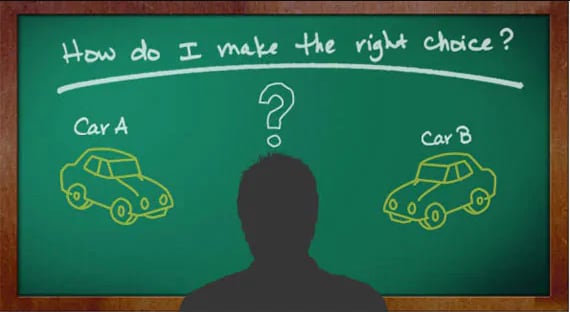The 5-Year Cost to Own is the total amount of vehicle-related costs you will likely have to cover during the first 5 years of owning a car. This includes out-of-pocket expenses like fuel and insurance, and vehicle depreciation (loss in value).
What Does 5-Year Cost to Own Include?
Fuel - the cost to fill up, based on 15,000 miles per year
Maintenance - what it costs to keep the car running well
Insurance - the average in your state, including collision and liability
Repairs - based on a no-deductible extended warranty
Financing - since most people don't have the cash on hand to buy the car outright
State fees - items like sales tax, license and registration
Depreciation (Loss in Value) - the difference between what you paid and what it's worth
How Does It Help You Compare?
Even if two vehicles are priced the same, that doesn't mean they will cost the same over time. Knowing the 5-Year Cost to Own ahead of time can help you save money in the long run.


What you paid for the car 5 years ago
Fuel, Insurance, Financing, State Fees, Maintenance and Repairs
The loss in the vehicle's value since the purchase date
Lowest 5-Year Cost to Own by Class
Don't Get Stuck, Choose Wisely
Inside Kelley Blue Book's 5-year Cost to Own

Let's say you're in the market for a new car and you’ve narrowed your list down to two cars: Car A and Car B. They even have the same price. So how do you choose?
At Kelley, we dive deep to help you tell them apart from a cost standpoint. After all, cars cost a lot more than their purchase price. You also need to pay for things like fuel, maintenance and insurance.
The bottom line is: Even if a certain car costs more to buy up front, it may actually save you money over the first five years of ownership. Knowing the difference could help keep money in your pocket.
What gives one car a lower cost to own vs its competitors?
Some differences are easy to understand. If Car A gets 30 MPG and Car B gets 25 MPG, you'll spend more money on fuel with Car B.
Other differences aren't as obvious. Like depreciation. All cars start to lose their value the moment you drive them off the dealer's lot, but certain new cars hold their value better than others over time.
If you trade in Car A after 5 years (the length of time many people keep their new car), it might still be worth a lot. Maybe we're projecting there will be a huge market for 5-year-old Car As and dealers and private buyers will be clamoring to get their hands on one.
Car B may not be so lucky. It's still in great condition and has the same number of miles on it, but the market for Car Bs won’t be as strong in 5 years.
How do we know? We're experts in this type of information. With more than 90 years in the car business and access to incredible amounts of data, there may be no better source than Kelley Blue Book for figuring out long term values and day-to-day costs.
What if I don't keep the car for 5 years?
In order to provide a good "apples-to-apples" comparison, we have to make a few assumptions. The biggest one is that we show 5-year cost to own – that is, that you'll own the car for 5 years then sell it (or trade it in) for another car.
Since the largest depreciation happens in the first three years, people who buy a new car frequently should pay special attention to depreciation.
In the same way, other ownership factors might matter more to you, depending on how you use the car – and where you live.
Drive more than 15,000 miles? The impact of fuel economy is greater. Got a bad driving record? You'll probably pay more for insurance than our average. Independently wealthy? You won't need to worry about financing.
This is all to say that Kelley Blue Book's 5-Year Cost to Own is a great measurement when comparing new cars, but, as they say in the car commercials, "Your mileage may vary."
Where can I see a car's 5-Year Cost to Own?
You'll find it throughout kbb.com. Simply choose "What Should I Pay for a New Car" and "5-Year Cost to Own" is clearly displayed to the left of our pricing information.
In addition, we help you compare 5-Year Cost to Own among different cars and show you the ones with the lowest 5-year Cost to Own in a variety of categories and segments.
In 2012, we even started giving awards for the cars with the lowest ownership costs - the 5-Year Cost to Own Awards. Find the latest winners, here.
Fair Market Value and 5-Year Cost to Own are just two of the ways kbb.com helps you make an informed, confident decision when buying your next new car. No wonder we've been The Trusted Resource for consumers and the auto industry alike since 1926.
Latest 5-Year Cost to Own Award Winners
See Kelley Blue Book’s Best Electric Vehicle Best Buy for 2025, the Hyundai Ioniq 5.
Kelley Blue Book’s Consumer Choice Awards recognize the automakers whose brands caught the attention of new-car shoppers at KBB.com.
Kelley Blue Book’s Consumer Choice Awards recognize the automakers whose brands caught the attention of new-car shoppers at KBB.com.
Research New Vehicles
Popular New Makes
Popular New Cars and Trucks
- Acura TLX
- BMW 3-Series
- Chevrolet Corvette
- Chevrolet Tahoe
- Ford Bronco Sport
- Ford F150
- Ford Ranger
- GMC Sierra 1500
- Honda Accord
- Honda Civic
- Hyundai Sonata
- Jeep Gladiator
- Jeep Wrangler
- Kia Telluride
- Nissan Rogue
- Porsche 911
- Ram 1500
- Subaru Outback
- Tesla Model 3
- Tesla Model Y
- Toyota Corolla
- Toyota Highlander
- Toyota Tacoma
- Volkswagen Jetta
